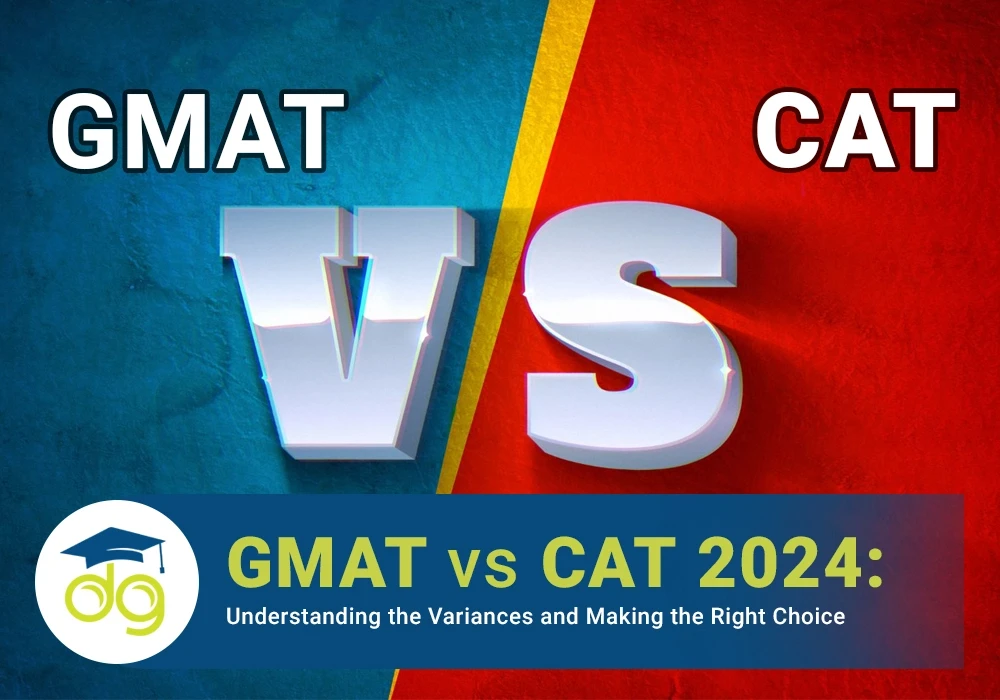GMAT Vs CAT 2024: Understanding the Variances and Making the Right Choice
Comparing GMAT and CAT: Key Differences to Guide Your MBA Journey
All those students who are planning for MBA usually undergo a position that either GMAT is better than CAT or vice versa. Many of the prestigious MBA Schools in the country admit students based on the score of the CAT which is a centralized exam in India.
On the other hand the graduate management admission test, which is also called GMAT is taken by over 7000 graduate management programs, present in 2000 business schools in universities in the world including some of the well recognized b-schools of India, XLRI, MDI and ISB.
Curious as to which examination might be more aligned with your objectives and profile? Regarding the distinctions between the GMAT vs CAT, the following information is vital.
Application candidates' quantitative ability, reasoning skills, and data interpretation skills are evaluated via online versions of both the GMAT and the CAT, which are standardized tests. The table below outlines the primary distinctions between these two preeminent MBA entrance courses.
|
Parameter |
GMAT |
CAT |
|
Organizing Institution |
Graduate Management Admission Council |
Indian Institute of Management |
|
Eligibility Criteria |
Applicants are required to be a minimum of 13 years old. There is no upper age restriction.
|
A minimum of 50% in the bachelor's program. There are no age restrictions. |
|
Acceptability of the Exam |
Business Schools around the globe |
Indian Business Schools |
|
Validity of the Exam |
Valid for five years |
Valid for 1 year. |
|
When Applicants Can Take the Exam |
Year-round (to be completed at the convenience of the student). |
The exam is held annually at a set time |
|
Exam Format and Duration |
There are four sections of 80 questions, all of which must be completed in 187 minutes. Integrated Reasoning, Verbal Reasoning, Analytical Writing Assessment, and Quantitative Reasoning comprise the four sections. |
Three sections consisting of 100 questions that have to be attempted in 120 Minutes |
|
Score Format |
Score+ percentile |
Only percentile is reported |
|
Exam Fee |
USD 250 |
INR 2,000 approximately |
|
Max number of attempts |
An annual maximum of 5 attempts is allowed. A 16-day interval should elapse between consecutive attempts. In total, 8 attempts are permitted in a lifetime. |
No such restriction except for the fact that the exam can be taken only once a year when conducted by the authorities. |
Now, let’s go dive into some of the critical differences:
GMAT Vs CAT Difficulty Scale:
It truly does depend on the type of preparation and the test-takers' personal comfort. The adaptive format and nature of the questions on the GMAT may make it more challenging for some candidates.
In order to optimize their score within the allotted time on the CAT, students are able to view the complete paper and discern which questions require their attention. You may only attempt to answer one question at a time on the GMAT, as you are limited to viewing it. A penalty is typically assessed for omitting a question on the GMAT.
Alternatively, a high percentile competition may make the CAT exam more challenging for some individuals. IIMs of the highest caliber, for example, require an admissions score of 99 or higher. In addition, the exam questions are marginally more difficult and the syllabus is marginally less structured than those on the GMAT, both of which exacerbate the difficulty of the preparation.
This brings us to our next point of comparison.
Syllabus Covered:
While the GMAT exam comprises of four sections namely Quantitative Reasoning, Verbal Reasoning, Analytical Writing, and Integrated Reasoning, the CAT consists of only 3 sections: Three are Knowledge Based Competencies that include Verbal skills and Reading ; numeration and Analytical capacity and reasoning.
Thus, as it has been rightly said, the GMAT also comprises the quantative ability; reasoning ability; data interpretation and the writing ability of the applicants.
The topics that are frequently assessed on both examinations are readily available online; however, the organizing institutes do not prescribe an exact syllabus. It is critical to consider the nature of the material that appears on the corresponding examinations as we compare the syllabi.
We shall examine each section of the syllabus individually:
Quantitative Ability
Quantitatively speaking, the CAT quant section is more challenging. The CAT evaluates more complex concepts pertaining to the same subject matter, whereas the GMAT poses relatively more elementary inquiries.
Verbal Ability
In contrast to the GMAT, which assesses critical reasoning and sentence correction in addition to reading comprehension, the CAT Verbal places a significantly greater emphasis on these skills.
The CAT does not, therefore, include a substantial portion of English grammar, whereas the GMAT does. As opposed to focusing on the grammatical structure of sentences and phrases, CAT applicants should prioritize paragraph structure.
The difficulty level faced by non-native candidates, for instance applicants from India, by far outweighs that delivered by the GMAT rather than the CAT test.
Determining whether CAT Data Interpretation & Logical Reasoning is better than GMAT Integrated Reasoning
Regarding this, the CAT Data Interpretation as well as the GMAT Integrated Reasoning sections seek to evaluate the candidate’s ability to interpret the data in graphs, charts, and possibly perform some mathematical computation.
The detail of the graphs and charts on the GMAT is greater in comparison to the CAT, which includes accompanying paragraphs of text.
Significantly different is the manner in which the CAT's DILR section contributes to the overall score, whereas the GMAT's IR section is not factored into the score out of 800 and its outcome is presented independently on the GMAT scorecard.
GMAT IR and CAT Logical Reasoning are diametrically opposed. Applicants must identify and comprehend logical patterns on the CAT LR. Although the GMAT does contain logical elements, comprehension of logical patterns is not directly assessed.
Adaptive vs. Non-Adaptive Format
An essential distinction between GMAT Vs CAT exam is their adaptive nature.
The GMAT questions possess an adaptive quality. In essence, this signifies that the level of difficulty of the subsequent question on the GMAT is determined by the response provided to the preceding question.
The examination begins with a question of average difficulty and progresses through the paper with questions that are either slightly easier or more difficult for the applicants.
This means that applicants are not permitted to skip or return to a question later. The examination must be completed question by question!
In contrast, the format of the CAT exam is not adaptive. Applicants have the ability to access the complete set of questions, formulate a plan regarding which questions to answer and in what sequence, assess their own answers, bypass those that they are uncertain about to prevent receiving negative grades and more.
Therefore, the examination attempts to assess the candidates' discernment by requiring them to select questions that will maximize their score within the allotted time.
Performance Evaluation:
GMAT scores offered to candidates fall within and start from 200 and go up to 800. The student is given an Analytical Writing Assessment score out of 6 points, an Integrated Reasoning score ranging from 1 to 8, and Verbal Reasoning and Quantitative Reasoning scores ranging from 0 to 60 in progressive order.
It is, therefore, important to reduce the scores to 800 and note that only the Verbal Reasoning and Quantitative Reasoning sections play a role in the score determination. Integrated Reasoning and the Analytical Writing Assessment are delivered as two different sections on the scorecard.
The CAT exam is taken out of 300 points. To give an exact response to each of the one hundred questions, the participant gets three points. The overall score involves the addition of the total number of correct responses and total number of wrong responses; an incorrect response earns the candidate a negative grade. Besides the total as well as sectional percentile score, CAT score also comes with a section-wise percentile score.
GMAT Vs CAT: Which one should I sit for?
Several factors, including the individual preference of the test taker, have an impact on this intricate discussion. Prior to reaching a decision, it is imperative to take into account the following key factors:
Target Schools:
The CAT is mostly popular in India and a limited number of global colleges.
Apart from 20 IIMs, 100+ business schools in India accept CAT scores. Some of the international schools such as SKEMA Business School, SP Jain Institute of Management, Singapore Management University also accept CAT scores.
The GMAT is accepted in more than 4000 business schools worldwide, including prestigious B-Schools such as Harvard Business School, Stanford, and others. ISB, XLRI, and other Indian institutions also accept GMAT scores. Detailed lists of Indian institutions that accept GMAT scores are provided below.
Consequently, the applicant must determine which schools they wish to apply to and base their exam preparation decisions primarily on those institutions.
Location:
If you are planning to study and settle abroad, chances are you would need a good GMAT score. If you are planning to study in India, a top CAT score will provide more opportunities.
Scholarships:
Upon passing the GMAT, almost all international universities provide access to merit-based, need-based, and external scholarship opportunities. Additionally, you should take this into account prior to selecting the most suitable examination.
FINAL BIT:
It is always advisable to consider every conceivable factor when deliberating between GMAT Vs CAT. An MBA is an excellent opportunity; therefore, rationalize thoroughly and make a well-informed choice to ensure a prosperous future career.
Visit Skoodos Bridge for further details regarding the institutes that offer coaching for both courses, they will be able to assist you in structuring your professional trajectory.
Categories
Archives
Similar Posts

Color Psychology in Note-Taking for Better Memory and Learning
by Skoodos Bridge

Mirror Neurons and Group Study: The Psychology Behind Collaborative Learning
by Skoodos Bridge

Music Therapy for Concentration: Playlists to Boost Focus While Studying
by Skoodos Bridge

Dopamine Hacking for Study Motivation: Neuroscience-Based Exam Prep
by Skoodos Bridge

Electric Vehicle Jobs: Top Mechanical Engineering Careers in EV Sector
by Skoodos Bridge

EdTech Careers After Engineering: Build Learning Apps & Startups
by Skoodos Bridge

Gaming Meets Medicine: VR Therapy Careers for NEET Aspirants
by Skoodos Bridge

WhatsApp Group Study: Boost Your Competitive Exam Preparation
by Skoodos Bridge

Drone Engineering Careers: Aerospace Pathways, Exams & Job Opportunities
by Skoodos Bridge


Leave a Comment